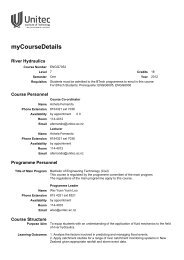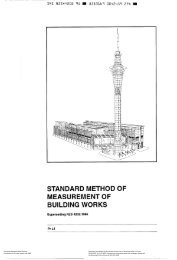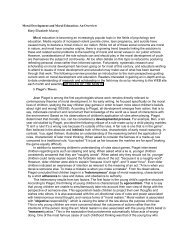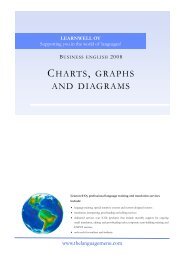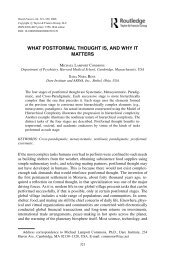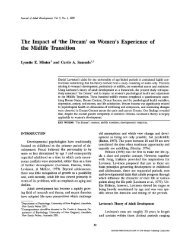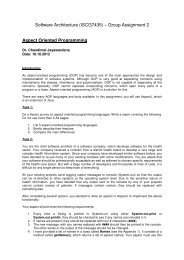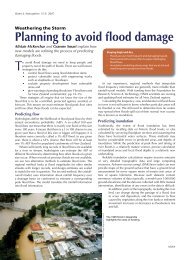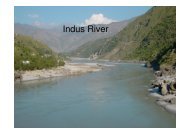7. Understanding critical flow
7. Understanding critical flow
7. Understanding critical flow
You also want an ePaper? Increase the reach of your titles
YUMPU automatically turns print PDFs into web optimized ePapers that Google loves.
Water and Rivers Commission<br />
Waterways WA Program. Managing and enhancing our waterways for the future<br />
The significance of super <strong>critical</strong> <strong>flow</strong><br />
Super <strong>critical</strong> <strong>flow</strong> conditions have both ecological and<br />
hydrological implications of great significance to stream<br />
management.<br />
For the stream ecosystem the hydraulic jump is a very<br />
significant component. Firstly it entrains air into the<br />
water column, oxygenating the stream ecosystem.<br />
Secondly, it provides a ‘launch pad’ for fish seeking to<br />
leap obstructions in their efforts to move upstream. For<br />
jumps that have a chute form, water may also swirl<br />
upstream either side of the fall of water, again assisting<br />
aquatic organisms to move upstream. Thirdly, the<br />
hydraulic jump is the only time that the pure movement<br />
of water makes sound (the babbling of brooks and the<br />
roaring of rapids), through the bursting of bubbles, as the<br />
entrained air rises to the surface. And fourthly, the<br />
super-<strong>critical</strong> <strong>flow</strong> conditions are primary habitat for<br />
certain aquatic organisms.<br />
For modified or human-made channels super<strong>critical</strong><br />
<strong>flow</strong> has advantages and disadvantages. It is not<br />
uncommon for engineers to create channels with<br />
sufficient depth, smoothness and slope to create super<br />
<strong>critical</strong> <strong>flow</strong>; in order to move water faster through a<br />
small narrow channel, and thus free-up land for<br />
development or reduce the amount of land that needs to<br />
be purchased. Such channels however are inherently<br />
dangerous and must be fenced-off. They must also be<br />
made of concrete or stone to prevent erosion from the<br />
powerful <strong>flow</strong>s.<br />
Super <strong>critical</strong> <strong>flow</strong>, with its high velocity and turbulent<br />
motion, often with standing waves and occurring on a<br />
slippery surface, presents a considerable hazard to<br />
people and other terrestrial fauna. Water, only a foot or<br />
two deep, but moving at a super <strong>critical</strong> velocity can<br />
sweep a person or animal downstream and hold them<br />
under water, as canoeists well know.<br />
The creation of super <strong>critical</strong> <strong>flow</strong> is not always<br />
intended. Channel modifications that result in a shorter<br />
than natural channel, such as meander cut-offs or<br />
channel straightening, can create a channel of very steep<br />
slope sufficient to cause super <strong>critical</strong> <strong>flow</strong>. The effect is<br />
enhanced when the new channel is made particularly<br />
smooth by desnagging or vegetation clearance.<br />
Needless to say, should the channel be formed in noncohesive<br />
material, serious erosion will result.<br />
An interesting way of observing super-<strong>critical</strong> <strong>flow</strong> is by<br />
throwing a stone into <strong>flow</strong>ing water and observing the<br />
ripples. If the ripples move upstream from the point of<br />
emanation then the <strong>flow</strong> is sub-<strong>critical</strong>, but if the ripples<br />
are swept downstream, then the <strong>flow</strong> is super-<strong>critical</strong>.<br />
Even better compare the rippling effect of objects<br />
projecting above the water at points upstream and<br />
downstream of <strong>critical</strong> <strong>flow</strong>. No ripples will travel<br />
upstream of the latter (Figure <strong>7.</strong>2).<br />
31



